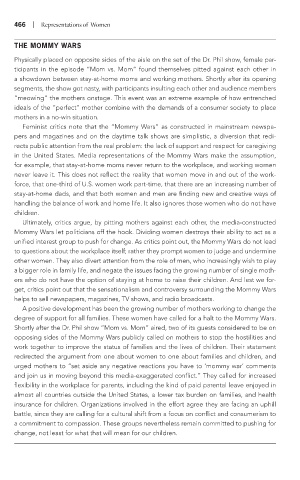Page 487 - Battleground The Media Volume 1 and 2
P. 487
| Representat ons of Women
the MoMMy wars
Physically placed on opposite sides of the aisle on the set of the Dr. Phil show, female par-
ticipants in the episode “Mom vs. Mom” found themselves pitted against each other in
a showdown between stay-at-home moms and working mothers. Shortly after its opening
segments, the show got nasty, with participants insulting each other and audience members
“meowing” the mothers onstage. This event was an extreme example of how entrenched
ideals of the “perfect” mother combine with the demands of a consumer society to place
mothers in a no-win situation.
Feminist critics note that the “Mommy Wars” as constructed in mainstream newspa-
pers and magazines and on the daytime talk shows are simplistic, a diversion that redi-
rects public attention from the real problem: the lack of support and respect for caregiving
in the United States. Media representations of the Mommy Wars make the assumption,
for example, that stay-at-home moms never return to the workplace, and working women
never leave it. This does not reflect the reality that women move in and out of the work-
force, that one-third of U.S. women work part-time, that there are an increasing number of
stay-at-home dads, and that both women and men are finding new and creative ways of
handling the balance of work and home life. It also ignores those women who do not have
children.
Ultimately, critics argue, by pitting mothers against each other, the media-constructed
Mommy Wars let politicians off the hook. Dividing women destroys their ability to act as a
unified interest group to push for change. As critics point out, the Mommy Wars do not lead
to questions about the workplace itself; rather they prompt women to judge and undermine
other women. They also divert attention from the role of men, who increasingly wish to play
a bigger role in family life, and negate the issues facing the growing number of single moth-
ers who do not have the option of staying at home to raise their children. And lest we for-
get, critics point out that the sensationalism and controversy surrounding the Mommy Wars
helps to sell newspapers, magazines, TV shows, and radio broadcasts.
A positive development has been the growing number of mothers working to change the
degree of support for all families. These women have called for a halt to the Mommy Wars.
Shortly after the Dr. Phil show “Mom vs. Mom” aired, two of its guests considered to be on
opposing sides of the Mommy Wars publicly called on mothers to stop the hostilities and
work together to improve the status of families and the lives of children. Their statement
redirected the argument from one about women to one about families and children, and
urged mothers to “set aside any negative reactions you have to ‘mommy war’ comments
and join us in moving beyond this media-exaggerated conflict.” They called for increased
flexibility in the workplace for parents, including the kind of paid parental leave enjoyed in
almost all countries outside the United States, a lower tax burden on families, and health
insurance for children. Organizations involved in the effort agree they are facing an uphill
battle, since they are calling for a cultural shift from a focus on conflict and consumerism to
a commitment to compassion. These groups nevertheless remain committed to pushing for
change, not least for what that will mean for our children.

